
Aquatint is an intaglio printmaking technique, a variant of etching that produces areas of tone rather than lines. For this reason it has mostly been used in conjunction with etching, to give both lines and shaded tone. It has also been used historically to print in colour, both by printing with multiple plates in different colours, and by making monochrome prints that were then hand-coloured with watercolour.
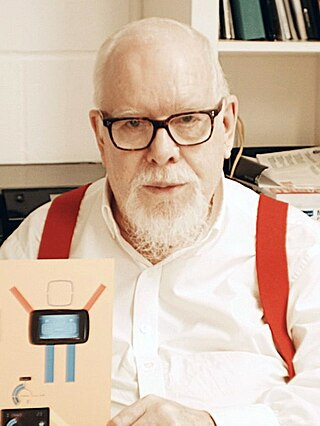
Sir Peter Thomas Blake is an English pop artist. He co-created the sleeve design for the Beatles' album Sgt. Pepper's Lonely Hearts Club Band. His other works include the covers for two of The Who's albums, the cover of the Band Aid single "Do They Know It's Christmas?", and the Live Aid concert poster. Blake also designed the 2012 Brit Award statuette.
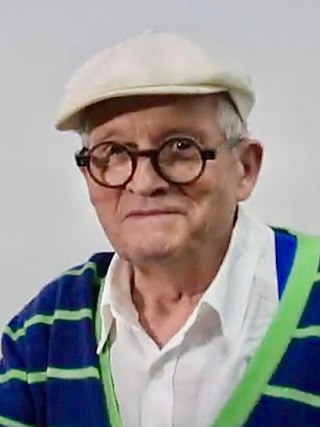
David Hockney is an English painter, draftsman, printmaker, stage designer, and photographer. As an important contributor to the pop art movement of the 1960s, he is considered one of the most influential British artists of the 20th century.

Konstantinos Petrou Kavafis, known, especially in English, as Constantine P. Cavafy and often published as C. P. Cavafy, was a Greek-Egyptian poet, journalist, and civil servant from Alexandria. His work, as one translator put it, "holds the historical and the erotic in a single embrace."

Edmund Blampied was one of the most eminent artists to come from the Channel Islands, yet he received no formal training in art until he was 15 years old. He was noted mostly for his etchings and drypoints published at the height of the print boom in the 1920s during the etching revival, but was also a lithographer, caricaturist, cartoonist, book illustrator and artist in oils, watercolours, silhouettes and bronze.
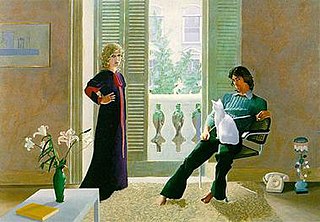
Mr and Mrs Clark and Percy is a painting by the British artist David Hockney. Painted between 1970 and 1971, it depicts the fashion designer Ossie Clark and the textile designer Celia Birtwell in their flat in Notting Hill Gate shortly after their wedding, with one of the couple's cats on Clark's knee. The white cat depicted in the painting was Blanche; Percy was another of their cats, but Hockney thought "Percy" made a better title.

Banks' Florilegium is a collection of copperplate engravings of plants collected by Sir Joseph Banks and Daniel Solander while they accompanied Captain James Cook on his first voyage around the world between 1768 and 1771. They collected plants in Madeira, Brazil, Tierra del Fuego, the Society Islands, New Zealand, Australia and Java. During this voyage, Banks and Solander collected nearly 30,000 dried specimens, eventually leading to the description of 110 new genera and 1300 new species, which increased the known flora of the world by 25 per cent.
Colin E Self is an English Pop Artist, whose work has addressed the theme of Cold War politics.

William Blake's Illustrations of the Book of Job primarily refers to a series of twenty-two engraved prints by Blake illustrating the biblical Book of Job. It also refers to two earlier sets of watercolours by Blake on the same subject. The engraved Illustrations are considered to be Blake's greatest masterpieces in the medium of engraving, and were also a rare commercial and critical success for Blake.

Aldo Crommelynck was a Belgian master printmaker who made intaglio prints in collaboration with many important European and American artists of the 20th century.

James McBey was a largely self-taught artist and etcher whose prints were highly valued during the later stages of the etching revival in the early 20th century. He was awarded an Honorary Doctor of Letters by Aberdeen University.

The illustration of manuscript books was well established in ancient times, and the tradition of the illuminated manuscript thrived in the West until the invention of printing. Other parts of the world had comparable traditions, such as the Persian miniature. Modern book illustration comes from the 15th-century woodcut illustrations that were fairly rapidly included in early printed books, and later block books. Other techniques such as engraving, etching, lithography and various kinds of colour printing were to expand the possibilities and were exploited by such masters as Daumier, Doré or Gavarni.
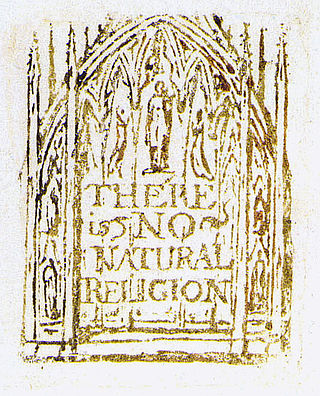
There is No Natural Religion is a series of philosophical aphorisms by William Blake, written in 1788. Following on from his initial experiments with relief etching in the non-textual The Approach of Doom (1787), All Religions are One and There is No Natural Religion represent Blake's first successful attempt to combine image and text via relief etching, and are thus the earliest of his illuminated manuscripts. As such, they serve as a significant milestone in Blake's career; as Peter Ackroyd points out, "his newly invented form now changed the nature of his expression. It had enlarged his range; with relief etching, the words inscribed like those of God upon the tables of law, Blake could acquire a new role."

Katharine Cameron RWS RE was a Scottish artist, watercolourist, and printmaker, best known for her paintings and etchings of flowers. She was associated with the group of artists known as the Glasgow Girls.

Belshazzar's Feast is an oil painting by British painter John Martin (1789–1854). It was first exhibited at the British Institution in February 1821 and won a prize of £200 for the best picture. It was so popular that it needed to be protected from the crowds by a railing, and established Martin's fame. In the words of Martin's biographer William Feaver, he "turned literary references to visual reality". Martin published mezzotint engravings in 1826 and 1832. The original painting is now held in a private collection; two smaller contemporaneous "sketches" are held by the Yale Center for British Art in New Haven, Connecticut and the Wadsworth Atheneum in Hartford, Connecticut.

Richard John Spare is a British artist known primarily for his drypoints, etchings and oil paintings. He is based in London.

Peter Jeffrey Matthews is a British printmaker, former teacher at Royal College of Art (RCA) and senior lecturer at Wimbledon School of Art. Educated at Ealing School of Art, Matthews went on to assist at Editions Alecto and editioned most of David Hockney's early etchings. Matthews has also exhibited his own work extensively including at the Royal Academy of Arts (RA), Royal Watercolour Society (RWS) Gallery, and with the Royal Society of Painter-Printmakers, being elected a Fellow and later Council Member 1984–98. His work is held in a number of public collections in the UK and overseas, including the Victoria & Albert Museum (V&A); British Council;the Ashmolean Museum; Albertina Museum, Vienna; Royal Library of Belgium and the Free Library, Philadelphia.
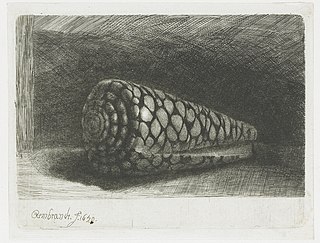
The Shell, also known as Rembrandt's Shell or Conus Marmoreus, or in Dutch as De schelp or Het schelpje, is a 1650 drypoint and etching by Rembrandt van Rijn. Catalogued as B.159, it is Rembrandt's only still life etching. Only a handful of original prints are known, in three states.

The War is a series of 50 drypoint and aquatint etchings by German artist Otto Dix, catalogued by Florian Karsch as K.70 to K.119. The prints were published in Berlin in 1924 by Karl Nierendorf, in an edition which included separate high quality folio prints, and a lower-quality version with 24 prints bound together. It is often compared to Francisco Goya's series of 82 engravings The Disasters of War. The British Museum, which holds a complete set of the folio prints, has described the series as "Dix's central achievement as a graphic artist"; the auction house Christie's has described it as "one of the finest and most unflinching depictions of war in western art".
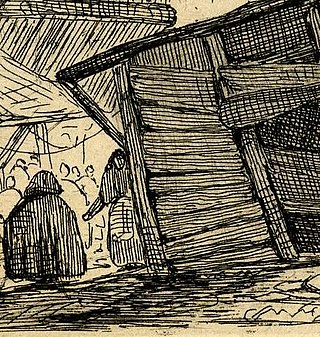
In printmaking, surface tone, or surface-tone, is produced by deliberately or accidentally not wiping all the ink off the surface of the printing plate, so that parts of the image have a light tone from the film of ink left. Tone in printmaking meaning areas of continuous colour, as opposed to the linear marks made by an engraved or drawn line. The technique can be used with all the intaglio printmaking techniques, of which the most important are engraving, etching, drypoint, mezzotint and aquatint. It requires individual attention on the press before each impression is printed, and is mostly used by artists who print their own plates, such as Rembrandt, "the first master of this art", who made great use of it.



















